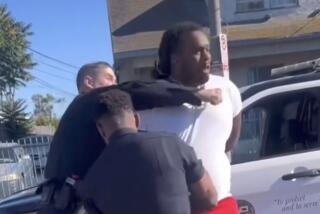Chief Says Need for Homicide Staff ‘Critical’
- Share via
Acknowledging that most people who commit murder in Los Angeles County get away with it, Los Angeles Police Chief Willie L. Williams said his department has a critical need for more detectives and criminalists to bring more killers to justice.
“While the city is currently giving primary emphasis to hiring more patrol officers, I firmly believe that the city also needs to give equal emphasis to providing the department with more detectives,” Williams wrote to the Police Commission, which has scheduled a discussion on the state of homicide investigations for its meeting Tuesday. “The need is definitely critical.”
Williams said he hopes the city will soon receive a federal grant that will allow it to hire more criminalists and upgrade its unaccredited and heavily backlogged crime laboratory.
The chief, whose department investigates half of the nearly 2,000 homicides that occur each year countywide, was responding to a recent Times study of five years of homicides in Los Angeles County.
Among the study’s conclusions were that laboratory technicians, detectives and prosecutors are overwhelmed by too many murders and are operating ineffectively. The 20-month study found that only one in three killings in the county leads to a homicide conviction.
“My overall perception is that The Times’ study . . . is very accurate,” wrote the chief who, along with Dist. Atty. Gil Garcetti and Sheriff Sherman Block, had declined to be interviewed for the study. “The research findings provide the public with a true picture of how serious the homicide problem has become in Los Angeles County.”
Police Commission Executive Director Richard Dameron said the chief has promised to give the commission a report in a few weeks on how the department can improve its homicide investigations and work more effectively with prosecutors.
Many prosecutors told The Times they believe LAPD homicide investigations are inferior, when compared as a group, to homicide investigations done by the Sheriff’s Department. They also said LAPD detectives were less willing or able than sheriff’s detectives to cooperate with prosecutors seeking additional investigation once a suspect had been charged.
Part of the difference may be attributable to workload. Experts say homicide investigators should be expected to handle no more than eight to 10 killings a year. Sheriff’s detectives handle on average 14 homicides per year. In the LAPD’s busiest divisions, some detectives say they handle more than 20.
*
The two agencies had dramatically different arrest and conviction records. Excluding the 2% of cases resolved in Juvenile Court, the study found that 38% of the sheriff’s cases ended in charges being filed compared to 54% of LAPD’s cases. But the LAPD’s cases were more likely to fall apart in court. When all was said and done, about one in three of the homicides each agency investigates ends in a murder or manslaughter conviction.
In a “fact sheet” attached to Williams’ letter, the LAPD suggested to the Police Commission that a large number of gang-related homicides in the city might explain the differences in the agencies’ performances.
The study found that this did not explain the difference--that the percentage of gang-related killings the LAPD handled was only slightly larger than the percentage handled by the Sheriff’s Department: 39% to 36% during the 1990 through 1994 study period.
Responding to the finding that police detectives are so overworked that they cannot even follow all credible leads, the LAPD acknowledged only that detectives have to prioritize cases and handle the most “favorable leads first.”
The department also said that the LAPD has “long recognized the need to upgrade” its laboratory facilities and staff to improve support for detectives.
Detective workloads are so extreme, the fact sheet said, that “if the number of detectives is not increased, the department may soon be unable to find enough detectives willing to work homicide.”
It attributed difficulty in winning convictions in part to lack of cooperation from witnesses in gang cases, either because the witnesses are gang members, fear reprisals from gang members or simply dislike the police.
*
The newspaper series reported on more than 30 cases--the vast majority investigated by the LAPD--where innocent people were arrested and charged with murder, often because of sloppy investigations.
The fact sheet did not address investigative shortcomings in any of these specific cases, observing only that detectives often have to rely on limited evidence which, if deemed credible, must lead to an arrest. “If the wrong person is arrested because of questionable investigative practices and/or mistaken identity, the arrested person will always be released as soon as the mistake is revealed,” the LAPD said.
The department also did not address in detail instances in which evidence established that LAPD officers falsely testified or withheld crucial evidence in murder cases. Noting the newspaper’s conclusion that there were lingering questions about the officers’ intent in these cases, the department said: “There will always be cases which come down to ‘who do you believe.’ Absent convincing evidence to the contrary, the department must believe in the integrity of its officers.”
The department defended its practice of closing out its investigations in some cases when the district attorney rejects them for prosecution. The LAPD said it was acting in accordance with FBI guidelines that allow an agency to consider a case cleared if it feels it has identified the killer but, because of factors out of its control, cannot get prosecutors to file charges.
The newspaper’s study found 200 cases classified this way by the LAPD. Some involved shootouts where the killer was known but prosecutors thought they would not be able to overcome a claim of self-defense. Others involved cases in which key witnesses could not be located.
More to Read
Sign up for Essential California
The most important California stories and recommendations in your inbox every morning.
You may occasionally receive promotional content from the Los Angeles Times.










